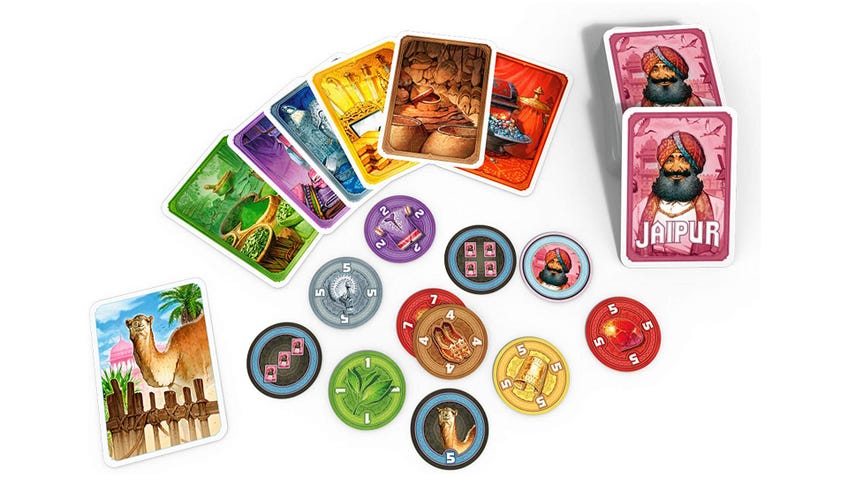Two-player board games prove that less can be more
1 + 1 = Fun.
Finding people to play board games with is hard. Adults have disappointingly busy lives and are notoriously difficult to organise. Gathering the number of players needed for larger titles like Twilight Imperium: Fourth Edition or Eldritch Horror often feels like an unreachable dream. Which is why two-player board games are such a blessing.
Tricking another person into playing a game with you is much easier than trying to fool four people into doing it, especially if that person is trapped with you on a plane, in a waiting room or in your living room because it’s the coolest part of your house. But two-player board games aren’t only great because they’re convenient, they also offer the kind of intimate gameplay experience that you simply cannot find anywhere else.
Whilst board games that support at least two players have consistently been the most widely published tabletop titles out there – at least until last year, where games that supported at least one player overtook it for the first time – they don’t provide the same experience as two-player-only board games.
There’s a wealth of differences between games that can support a number of players versus those that cater to an exact number. Two-player-only board games feel like they’ve been finely tuned, carefully constructed to work within their limitations to provide a gameplay experience that’s unlike any other. A good two-player game will have players facing off against each other in an intense competition – or sometimes bonded to one another in a co-op mode – that inspires the kind of competitiveness that may well make or break a relationship.
A smaller player count means that creators can predict how games can play out with fewer potential factors involved.
A prime example of a two-player game that inspires this level of competitiveness is Jaipur, a card-drafting game about trying to nab the best deals at a local market for the sultan. Jaipur’s innate ability to encourage intimate competitiveness comes almost entirely from its combination of card-drafting and set collection, because they inevitably lead to players having to take actions that are going to directly upset their opponent’s plans. For instance, players want to take matching cards into their hands so they can exchange them for point tokens later. However, the highest scoring cards also happen to be the rarest, meaning that players will be vying for them early on. Lo and behold, you’re going to have a situation where one player manages to nab the last remaining cards for a rare set, leaving their opponent out in the cold.
It’s aspects like these that make Jaipur a perfect two-player board game, because the designer has been able to deliberately craft them around the fact that there are only two people who could be playing. That smaller player count means that creators can predict how games can play out with fewer potential factors involved, allowing them to hone the experience they provide down to a finely crafted tee.

Another example of a great two-player game that perfectly reflects this ethos of close competitiveness is Patchwork. Another drafting title, Patchwork has players selecting and placing pieces of varying shape and size on their own individual player boards, with the aim of covering as much space as possible and gathering as many button pieces as they can.
The main way that Patchwork encourages competitiveness between its two players is through the turn tracker board, which tracks which player has the next turn and how long, roughly, they have until the game ends. Certain pieces that players can take in Patchwork require them to move their token along the turn tracker, which can trigger an event where players are able to take as many buttons as they have shown on their player boards.
Players are so focused on the back-and-forth of each other’s actions - it’s what primarily drives the pace and keeps us so invested.
Whichever player’s token is the furthest behind will be able to take their turn, with this continuing until their token has caught up or overtaken their opponent’s. This means that the decision to take a piece isn’t just driven by the desire for that particular piece, but also driven by whether it’ll lead to their opponent being able to have several turns in a row – potentially giving them full reign over the pool of pieces for longer than they’d like.
That is the beauty of a two-player game like Patchwork, almost every decision a player makes is determined by what their opponent could do. There are certainly plenty of other board games that encourage similar behaviour, but none so much as two-player board games like Patchwork and Jaipur. This is also what creates the intimacy of two-player board games, as players are so focused on the back-and-forth of each other’s actions - it’s what primarily drives the pace and keeps us so invested.
Two-player board games occupy their own unique space in the tabletop world for a reason and that’s because there’s simply nothing else like them. No other type of game inspires the same level of fervent desire for triumph and desperate fear of failure as two-player games - that’s why less can be more when it comes to board games.


